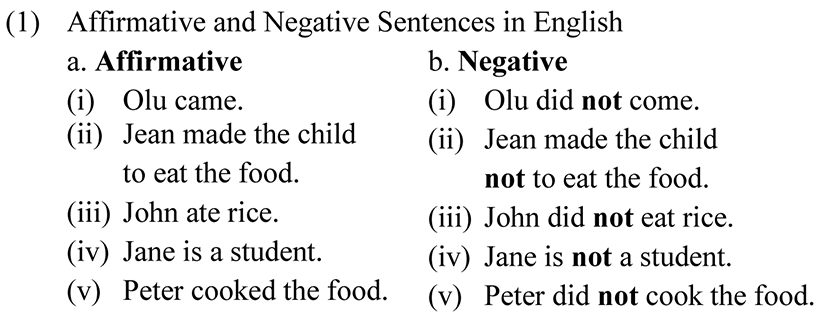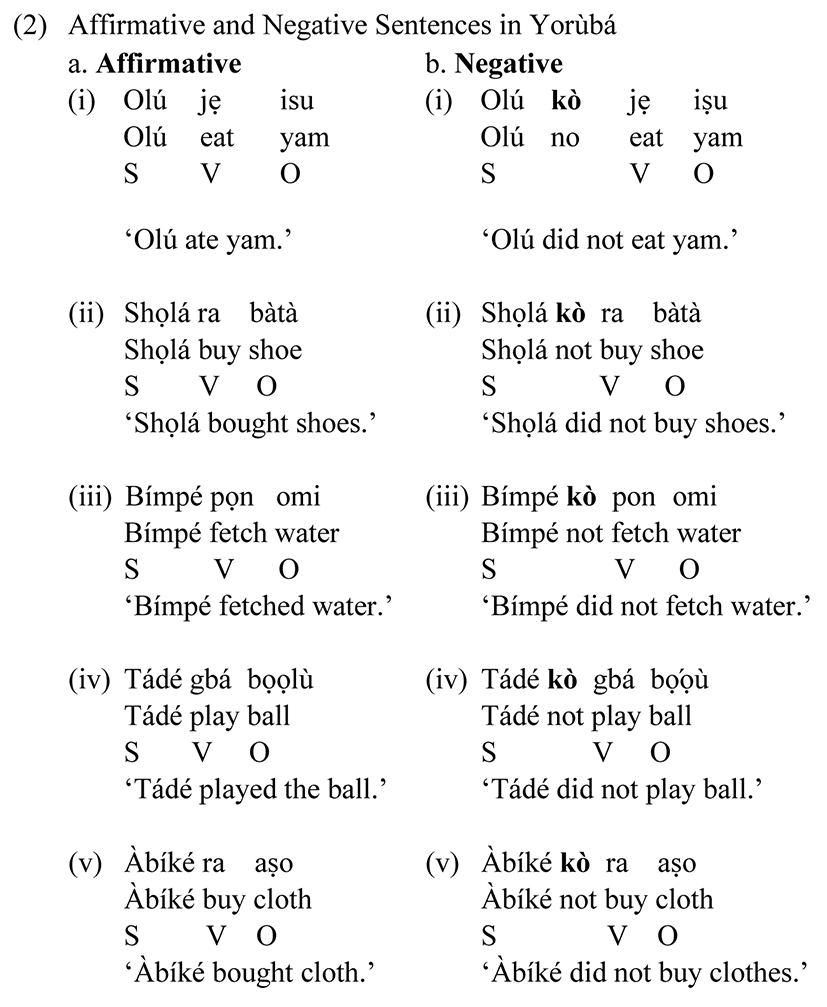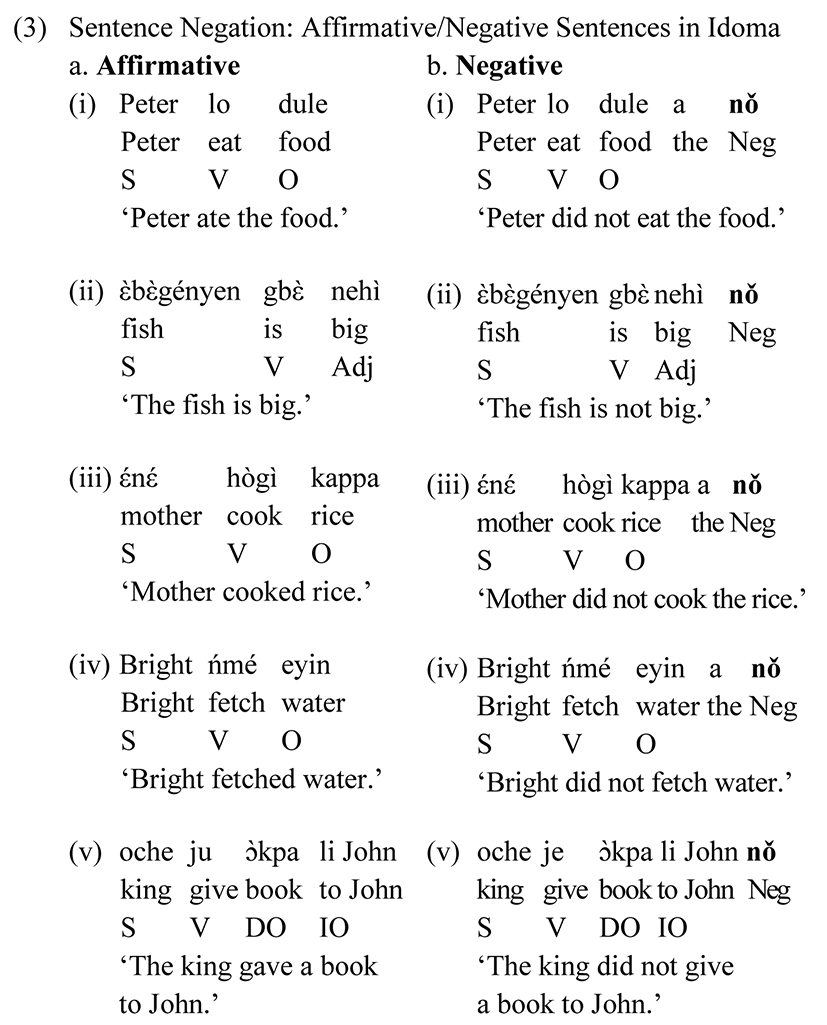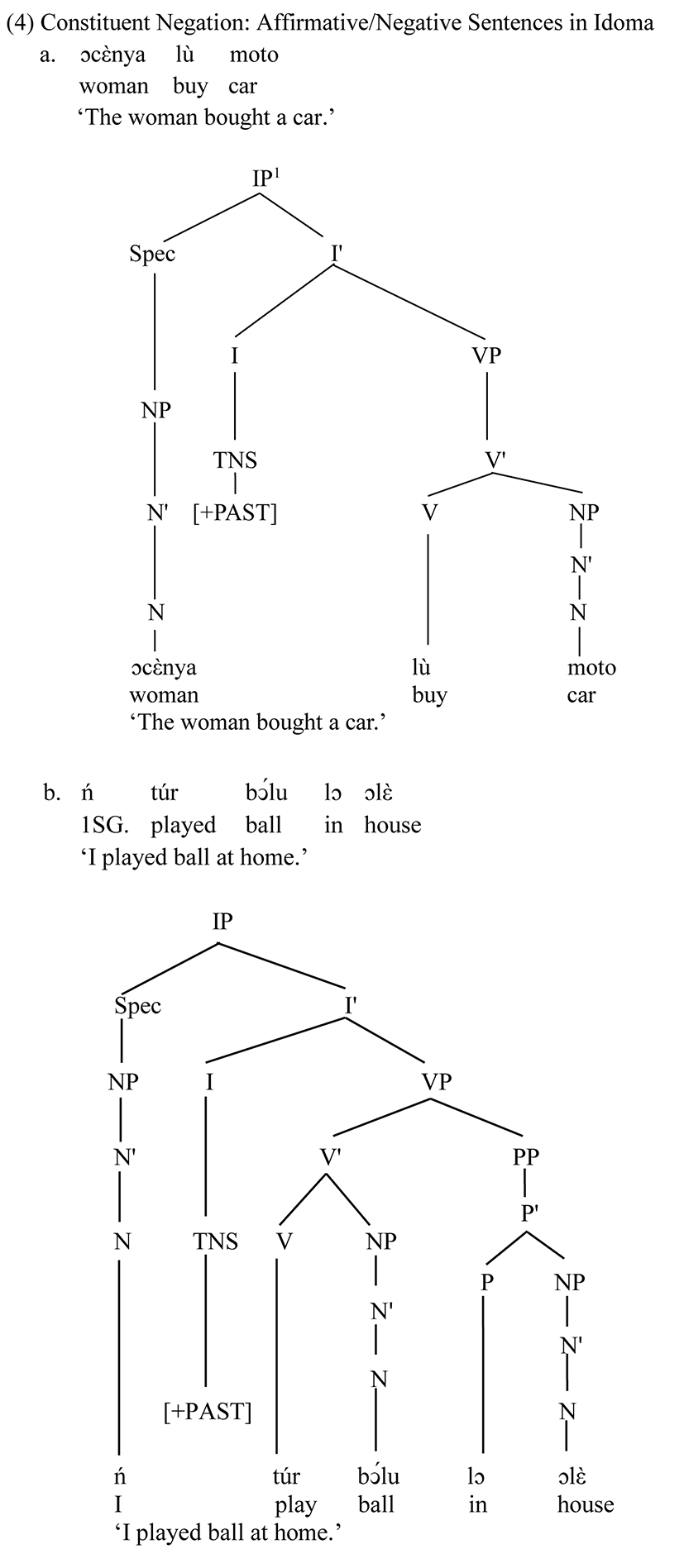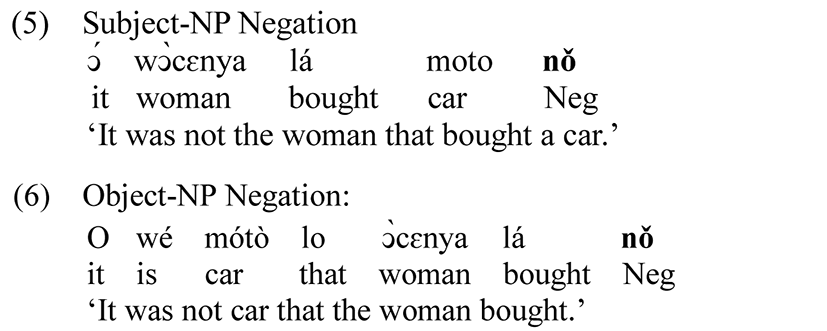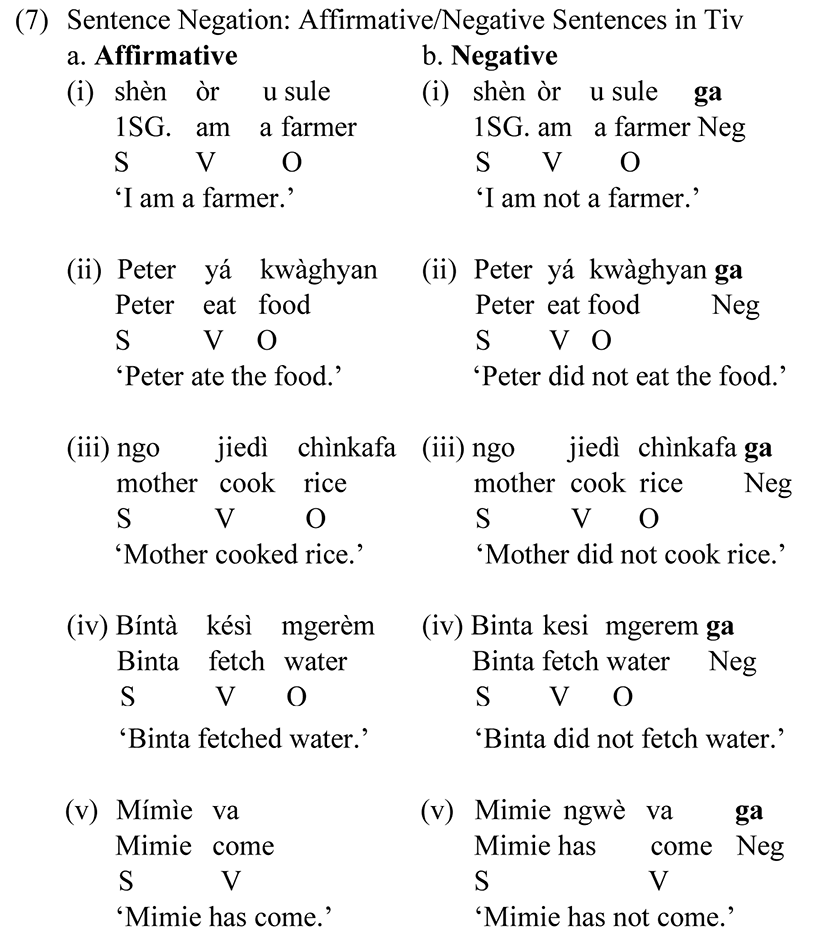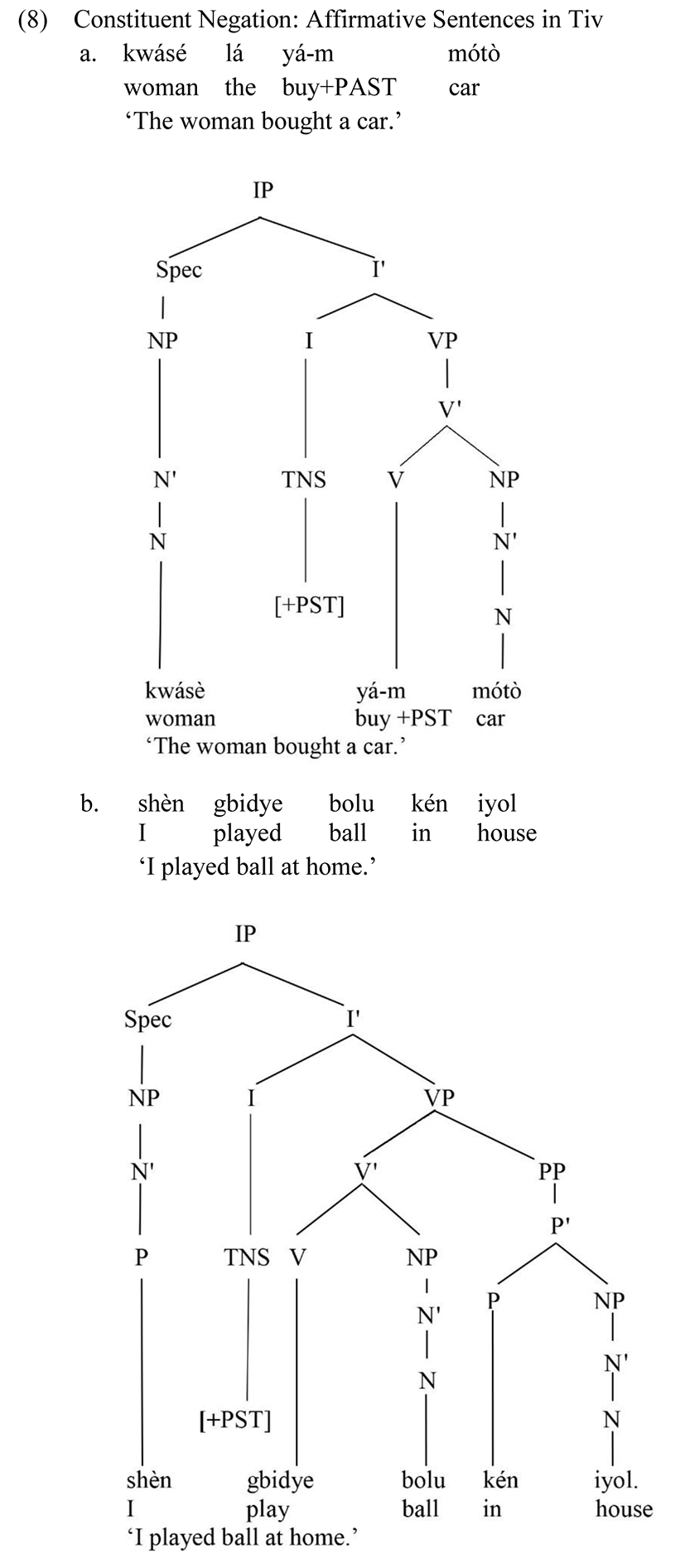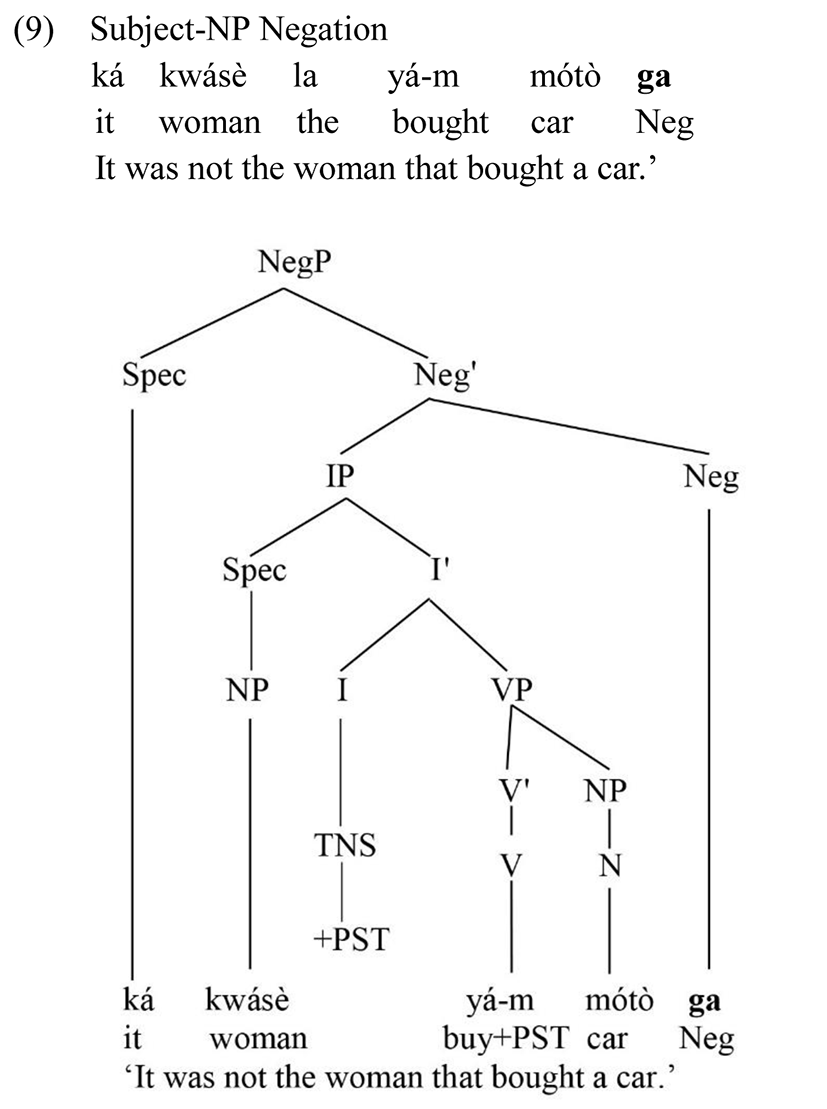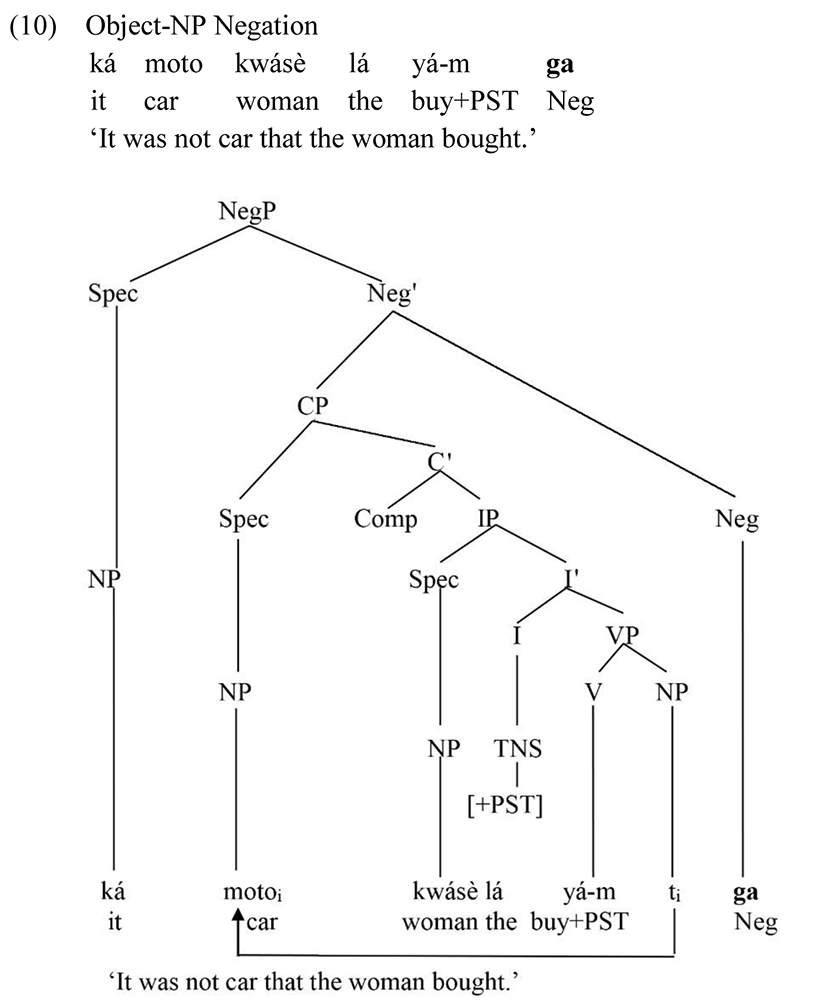1. Introduction
Negation is a syntactic phenomenon that has generated a lot of investigations in the field of linguistics. Efforts have been made by experts to examine the syntactic positions occupied by the ‘negator’ in a given grammatical sentence. The objective of this study is to examine the similarities and differences between the negative marking strategies in both Idoma and Tiv languages spoken in Benue State, Nigeria. The main purpose of the study is to find out whether or not their common genetic relationship, being members of Benue-Congo, reflects the language universal validity about negative marking. The investigation was carried out through an examination of both sentence and constituent negation in the two languages.
2. Idoma: The Language and Its Speakers
Armstrong (1955: 91) submits that the Idoma people occupy the area from Keana through Doma and Agatu districts of Lafia and Nasarawa and the Nkum in Ogoja area of the present Cross River State. Erim (1981: 3) also states that the Idoma lived within the ancient Kwararafa confederacy before AD 1800 and that they were Jukun or Jukun-related in origin.
However, many Idoma kindred, trace their origin to an ancestral homeland called Apa, North-East of the present-day Idomaland. The historical Apa was part of the ancient Kwararafa Kingdom (Okolofa Kingdom), a confederacy of several people. According to Umaru (2016: 3), “Idoma is the language spoken by the Idoma people who are predominantly found in Benue State with clusters of them found among other ethnic groups, especially Afoand Alago in Nasarawa State and Yala.”
Other linguistic groups that share close relationship with the Idoma of Benue State are: the Gede in Federal Capital Territory, Abuja, Afa, and Alago in Nasarawa State, Igala, and Ebira in Kogi State, Akweya and Etulo in Benue State, as well as Jukun in Taraba State. These languages and Idoma have a high degree of mutual intelligibility due to their historical and genetic commonalities. The Idoma language belongs to the Idomoid language family, a member of the Benue-Congo language family (see Figure 1).
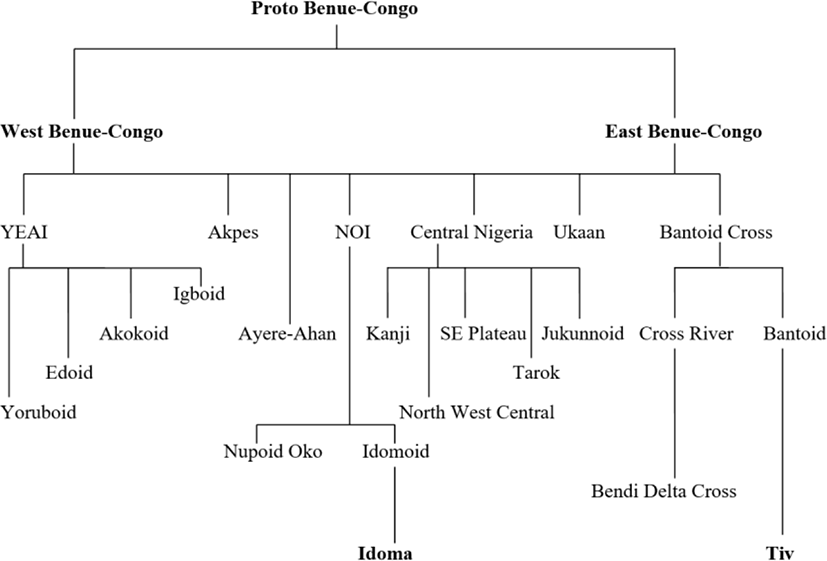
According to Gbor (1978: 9-12), the Tiv people have Bantu origin. He maintains that the migrant Tiv coming from their original home-land in Congo passed through Swem where they settled for sometime before arriving at their present-day location at the middle belt in Nigeria. Continuing their journey down from the Swem hills, the migrant Tiv came in contact with a new group of people called the Chamba. It was while they were staying with these people that the Tiv learned to develop a relatively advanced culture. This was particularly in the areas of food crops, hunting methods, marriage by bride price, and form of chieftaincy tradition.
However, the Tiv did not stay for too long with the Chamba. A war broke out between these two groups in which the Tiv suffered defeat. Having been defeated and driven away by the Chamba, they headed to their present-day habitat in the middle belt. As noted by Akiga (1965: 13), the area covered by the Tiv in the middle belt region is the “pleasant savannah country to the south of the River Benue and a narrow strip along its north bank”. Atel (2004: 7) reports that Tivland is surrounded by neighbouring ethnic groups such as the Udam who are made up of a collection of ethnic groups on the south, the Jukum, the Chamba, and the Mumuye on the East, the Alago, Angwe, and Koro on the North, and the Idoma, Igede and Igala on the West. Genetically, Tiv belongs to the Bantoid language family, a sub-family of Benue-Congo language family.
The language family tree showing the genetic classification of Idoma and Tiv is shown in (Figure 1).
This study is intended to find out the extent to which the negative marking strategies in the two languages under study conform to the assumption under language universals. The assumption is that there is an overall tendency for the negative marker to precede the main verb in SVO languages.
The theoretical framework adopted for our analysis in this work is Government and Binding (GB) theory, otherwise known as Principles and Parameters approach. Haegeman (1991: 13) considers GB as a theory of universal grammar (UG), consisting of all the principles and parameters that are common to all natural languages. Also, Sanusi (2017: 21) defines GB as a “modular deductive theory of UG, which posits multiple levels of representation related by the transformational rule (Move Alpha)”.
According to Cook & Newson (2007: 3), “This model claims that human languages consisted of principles that were the same for any grammar and parameters that allow grammars to vary in limited ways”. Also, Sanusi (2017: 21) explains that GB theory greatly eliminates proliferation of transformational rules like: passive, affix-hopping, verb-number agreement, question formation, equi-NP deletion, raising, permutation, insertion, etc.
In GB theory, the grammar is a continuous interaction between components and sub-theories embodying different principles and parameters. Furthermore, Horrocks (1987: 29) explains that, the core grammar of a given language is derived from the interaction of sub-theories of UG. These sub-theories are inter-related that each of them can account for grammaticality or ungrammaticality of any sentence.
3. Defining Language Universals
In his attempt to define the concept of language universals, Pericliev (2018: 34) traced the origin of the idea of language universals to Greenberg (1966). According to him, “A language universal is usually defined as a property that is valid for (or most) of the languages of the world.” In other words, the idea of language universals connotes what is common to all human languages. Furthermore, while considering the relationship between typological classification of languages and language universals, Malmkjaer (2002), makes the following remarks:
Some language universals are features present in all or an overwhelming majority of languages. Other universals are implicational: they state that if feature x is present in a language, then (it is highly likely that) feature y will also be present in that language.
This means that languages are typologized on the basis of the order in which Subject (S), Object (O), and Verb (V) typically occur in the simple sentence of the language, generally referred to as ‘Word Order’ typology. Greenberg (1966: 76) identifies the first three word orders (i.e., SVO, SOV and VSO) as the most commonly found among human languages. Dryer (1988: 93) in his study of the placement of negative marker in relation to the first three word order commonly found among languages (i.e., SVO, SOV, and VSO), he submits that SVO languages are most commonly SNegVO. Therefore, based on the ‘Word Order’ typology English language as an SVO language places its negative marker pre-verbally occurring after the first auxiliary in a verb phrase. The Yorùbá language, as an SVO language, also places its negative marker pre-verbally occurring before the main verb of the sentence. However, both Idoma and Tiv, which are also SVO languages, place their negative markers post-verbally, occurring at the sentence final position. This is contrary to the claim made under language universals that negative markers in SVO languages occur pre-verbally at the syntactic position between the subject and the verb.
According to Jackson (2007: 43), “negation is the expression of the denial or reverse of the state of affairs”. In English, the most common negative expression is the particle ‘not’ which is positioned after the first auxiliary in a verb phrase and often contrast (may not come, hasn’t been seen).’ Negation may, however, be expressed in a variety of ways (No dogs allowed; ‘You must never say that’, ‘she can be so uncaring’). Crystal (2008: 323) also submits that “negation is a process or construction in grammatical and semantic analysis which typically expresses the contradiction of some or all of a sentence’s meaning”. “Negation is a process of construction in grammatical and semantic analysis, which typically expresses the contradiction of some or all of the meaning of a sentence” (Lyons 1977: 75). Following Watter (2000), there are two different kinds of negation;
The study of negation has featured for centuries in the study of eminent logicians, philosophers, linguists and psychologists. As a result, many features of negation have been collected and investigated in many natural languages. This, therefore, provides the basis for the present study.
Languages differ as to the particular syntactic position which the negative markers assume in any given grammatical sentence. Syntacticians and typologists have carried out a cross-linguistic study of the syntactic position of the negative marker with respect to the verb in a given sentence. Greenberg (1966) and Dryer (1988) are well-known examples of such studies. They claim that there is an overall tendency for the negative marker to precede the verb.
Jespersen, in his study of the patterns of pre-verbal/post-verbal negation, identifies a strong tendency “to place the negative first, or at any rate as soon as possible, very often immediately before the particular word to be negated” (Jespersen 1917: 4).
Also, Dryer (1988: 93) presents a study of the placement of negative marker in relation to the three main clausal elements of subject (S), object (O) and verb (V) in a worldwide sample of 345 languages. He submits that SVO languages are commonly SNegVO. In other word, SVO languages place their negative markers pre-verbally, occurring at the position before the main verb. This section discusses the various syntactic positions occupied by the negative markers in some natural languages with SVO basic word order, similar to Idoma and Tiv languages.
According to Jackson (2007: 43), the most common negative expression in English is the particle ‘not’ which is positioned after the first auxiliary in a verb phrase. Haegeman (1995: 28) submits that the negative markers in English could occur at any of the following syntactic locations:
(i) within the auxiliary in sentences
(ii) as part of the subject nominal
(iii) as part of adverb of place
(iv) within a prepositional modifier
(v) within infinitival complements
The occurrence of negative marker in each of the above mentioned syntactic positions in English can be exemplified as in (1).
In the above examples in English language, the negative marker ‘not’ occurs after the first auxiliary and within the infinitival complement. English exemplifies a complex situation in which negation follows the auxiliary, but precedes the main verb. This motivates the construction of do-support in sentences where auxiliaries are not present.
Yorùbá belongs to the Kwa group of the Benue-Congo language family. It is a language spoken in the South-western part of Nigeria and some parts of African continent. The language has an SVO word order and attests negation. Like English, Yorùbá places its negative marker pre-verbally occurring before the main verb in any grammatical sentence. This shows that Yorùbá conforms to the assumption that SVO languages place negative marker pre-verbally.
This can be exemplified as shown in (2) below.
In the above examples in Yorùbá, the negative marker kò is placed pre-verbally, next to the main verb. In other words, the negative marker occurs before the main verb.
4. Negation in Idoma
In Idoma, the negative marker nǒ occurs at the sentence final position in any given negative construction. We can therefore say that Idoma negative marker occurs post-verbally, as against the universal based hypothesis of pre-verbal occurrence between the subject position and the inflected V. This can be exemplified with the data in (5) below.
5. Findings
Based on copious and relevant empirical data, the present study has made the following discoveries about the syntax of negation in Idoma and Tiv languages:
(i) It was discovered that despite the fact that the two languages exhibit SVO word order, they do not conform to the hypothesis that negative markers in SVO languages occur before or immediately after the verb in a given grammatical sentence (Dryer 1988).
(ii) From the available data, it was also discovered that both Idoma and Tiv have their negative markers consistently occurring at the sentence-final position, in a given negative construction.
(iii) As evidence to corroborate the existing position in the literature, effort was made to present data from English and Yorùbá, as two SVO languages that conform to the Language Universal Validity, in terms of the syntactic position of negative markers.
6. Conclusion
In conclusion, the syntactic position of negative markers in both Idoma and Tiv languages has been properly examined with relevant, copious and illuminating data from the two languages. It was discovered that the negative markers in each of the two languages occur at the sentence-final position. In addition to the fact that Idoma and Tiv belong to the same language family (Benue-Congo), they show a high degree of similarities, in terms of the syntactic position of the negative markers. And they both make use of overt negative markers in all cases of negative constructions. Based on the available syntactic evidence in the present study, it is recommended that further researches could be carried out on other SVO languages, with the hope of finding out the extent to which such languages conform to the assumed language universals.







